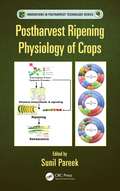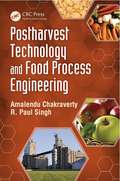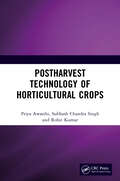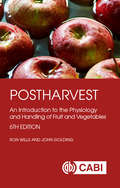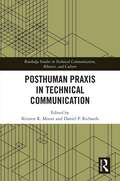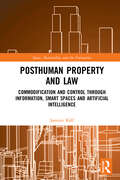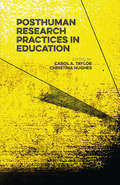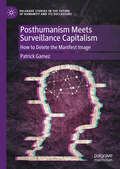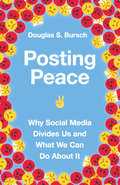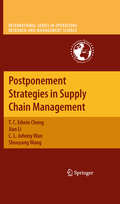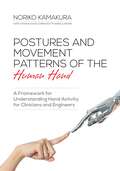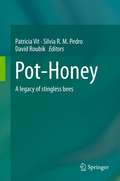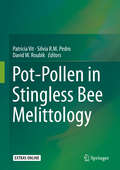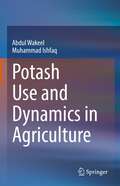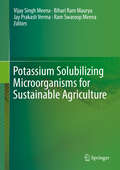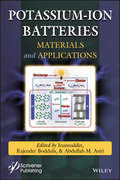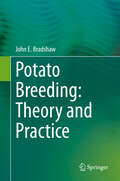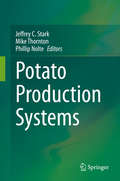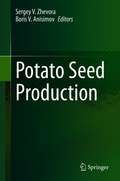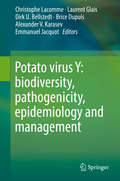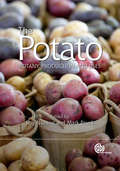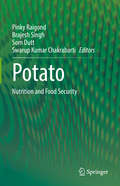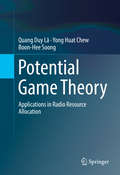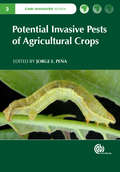- Table View
- List View
Postharvest Ripening Physiology of Crops (Innovations in Postharvest Technology Series)
by Sunil PareekPostharvest Ripening Physiology of Crops is a comprehensive interdisciplinary reference source for the various aspects of fruit ripening and postharvest behavior. It focuses on the postharvest physiology, biochemistry, and molecular biology of ripening and provides an overview of fruits and vegetables, including chapters on the postharvest quality
Postharvest Technology and Food Process Engineering
by Amalendu Chakraverty R. Paul SinghCereals, legumes, oilseeds, fruits, and vegetables are the most important food crops in the world, with cereal grains contributing the bulk of food calories and proteins worldwide. Generally, the supply of grains and other food can be enhanced by increasing production and by reducing postharvest losses. While food production has increased significa
Postharvest Technology of Horticultural Crops
by Rohit Kumar Subhash Chandra Singh Priya AwasthiThis book is an informative introduction to the post-harvest technology of horticultural crops, and their conservation and management. The different post-harvest handling operations including storage aspects are also covered. Innovative processing technologies like high-pressure processing, irradiation, cold plasma technique and ohmic heating are also discussed in the book.
Postharvest: An Introduction to the Physiology and Handling of Fruit and Vegetables
by Ron Wills John GoldingCompletely updated, this broad-based introductory level textbook covers the key concepts and practical technologies to slow the deterioration of harvested produce, including handling, packaging, transport, temperature management and the control of pests and diseases. The book retains the high quality color section and the content has been revised to reflect up-to-date information on the key issues of effective postharvest handling. New to the sixth edition: - Discussion of issues important to consumers and the impact of trends in convenience marketing on the quality of fresh-cut produce - Coverage of sustainability in terms of both energy used by technologies and non-synthetic disease and pest control systems - Greater consideration given to pre-harvest factors that influence quality - Additional information about the health benefits of plant antioxidant properties and a discussion of "superfoods. " This new edition is an invaluable resource for students of horticulture, plant physiology and food science, and industry personnel involved with the transportation, warehousing, marketing and retailing of fresh produce.
Posthuman Praxis in Technical Communication (Routledge Studies in Technical Communication, Rhetoric, and Culture)
by Kristen R. Moore Daniel P. RichardsThis collection, aimed at scholars, teachers, and practitioners in technical communication, focuses on the praxis-based connections between technical communication and theoretical movements that have emerged in the past several decades, namely new materialism and posthumanism. It provides a much needed link between contemporary theoretical discussions about new materialisms and posthumanism and the practical, everyday work of technical communicators. The collection insists that where some theoretical perspectives fall flat for practitioners, posthumanism and new materialisms have the potential to enable more effective and comprehensive practices, methodologies, and pedagogies.
Posthuman Property and Law: Commodification and Control through Information, Smart Spaces and Artificial Intelligence
by Jannice KällThis book analyses the phenomenon of digitally mediated property and considers how it problematises the boundary between human and nonhuman actors. The book addresses the increasingly porous border between personhood and property in digitized settings and considers how the increased commodification of knowledge makes visible a rupture in the liberal concept of the property owning, free, person. Engaging with the latest work in posthumanist and new materialist theory, it shows, how property as a concept as well as a means for control, changes fundamentally under advanced capitalism. Such change is exemplified by the way in which data, as an object of commodification, is extracted from human activities yet is also directly used to affectively control – or nudge – humans. Taking up a range of human engagements with digital platforms and coded architectures, as well as the circulation of affects through practices of artificial intelligence that are employed to shape behaviour, the book argues that property now needs to be understood according to an ecology of human as well as nonhuman actors. The idea of posthuman property, then, offers both a means to critique property control through digital technologies, as well as to move beyond the notion of the self-owning, object-owning, human. Engaging the most challenging contemporary technological developments, this book will appeal to researchers in the areas of Law and Technology, Legal Theory, Intellectual Property Law, Legal Philosophy, Sociology of Law, Sociology, and Media Studies.
Posthuman Research Practices in Education
by Carol A. Taylor Christina HughesHow do we include and develop understandings of those beyond-the-human aspects of the world in social research? Through fifteen contributions from leading international thinkers, this book provides original approaches to posthumanist research practices in education. It responds to questions which consider the effect and reach of posthuman research.
Posthumanism Meets Surveillance Capitalism: How to Delete the Manifest Image (Palgrave Studies in the Future of Humanity and its Successors)
by Patrick GamezThe core contention of this book is that, when viewed through the lens of contemporary posthuman theory, contemporary uses of AI under platform capitalism not only undermine our sense of the &“human&” but also our frameworks for conceptualizing ourselves as &“subjects&” or &“selves&” at all. This radical conclusion raises issues forces us to reckon with a new, disorienting horizon for critical thought at the intersection of technology and politics. This book demonstrates that two major streams of posthuman thought—namely, accelerationism and Prometheanism—can be interpreted as attempts to liberate our desires from our reason or our rationality from our all-too-human desire, each through the offloading of various tasks to emerging technologies. But, Patrick Gamez argues, the rise of opaque, unexplainable machine learning algorithms to predict and shape our behaviour undermines the common-sense models of mind through which we ultimately make sense of both the human and the posthuman.
Posting Peace: Why Social Media Divides Us and What We Can Do About It
by Douglas S. BurschWhy is everyone so angry online? The internet seems to have brought the world together only so we can tear each other apart. Social media platforms have become toxic and polarizing environments. Many of us are overwhelmed and disillusioned by endless online conflict and negativity. How did we get here, and what can we do about it? The internet changes not only how we communicate but also what we communicate. Pastor and former radio host Douglas Bursch provides a spiritual examination of why social media divides people and how Christians can address polarization through a ministry of peacemaking. Digital media dehumanizes and disembodies us, dulling our ability to know when to speak and when to remain silent. But healthy online communication is possible through a constructive posture of reconciliation. Bursch offers practical examples of how to proactively manage social media and handle online conflict in redemptive ways. Together we can change the discourse of online Christian communication. Discover how we can use social media in a positive, Christ-like manner.
Postponement Strategies in Supply Chain Management
by T. C. Cheng C. L. Wan Jian Li Shouyang WangWithin supply chain management (SCM), postponement is a deliberate action to delay final manufacturing or distribution of a product until receipt of a customer order. This reduces the incidence of wrong manufacturing or incorrect inventory deployment. Postponement strategies and practices serve to reduce the anticipatory risk in a supply chain. It can be fine-tuned or staged so that only the generic parts shared by a firm's various end products are warehoused, used only once orders come in for whichever products are selling, and will reduce inventory pressures throughout the firm. Despite much existing research in the area, no one book devoted solely to postponement has been published. At its core, Postponement Strategies in Supply Chain Management analyzes how both pull postponement strategy and form postponement strategy can be leveraged to yield substantial benefits to adopting firms in different competitive environments. The book is intended for researchers in supply chain management interested in conducting in-depth studies on postponement strategies. It is also intended for practitioners trying to understand the workings of postponement strategies and looking for guidance and decision support for the implementation of postponement strategies. Therefore, the book can be useful not only for researchers but also for practitioners and graduate students in operations management, management science, and business administration.
Postures and Movement Patterns of the Human Hand: A Framework for Understanding Hand Activity for Clinicians and Engineers
by Noriko KamakuraThink of the complexity of ordinary hand activity and how to describe it all, both precisely and concisely. The author, a noted occupational therapist in Japan, offers a disciplined approach to doing just that. Whereas research has heretofore been limited
Pot-Honey: A Legacy of Stingless Bees
by Patricia Vit David Roubik Silvia R. PedroThe stingless bees are one of the most diverse, attractive, fascinating, conspicuous and useful of all the insect groups of the tropical world. This is a formidable and contentious claim but I believe it can be backed up. They are fifty times more species rich than the honey bees, the other tribe of highly eusocial bees. They are ubiquitous in the tropics and thrive in tropical cities. In rural areas, they nest in a diversity of sites and are found on the flowers of a broad diversity of crop plants. Their role in natural systems is barely studied but they almost certainly deserve that hallowed title of keystone species. They are popular with the general public and are greatly appreciated in zoos and gardens. The chapters of this book provide abundant further evidence of the ecological and economic importance of stingless bees.
Pot-Pollen in Stingless Bee Melittology
by Patricia Vit Silvia R.M. Pedro David W. RoubikThis book covers pot-pollen—the other product, besides honey, stored in cerumen pots by Meliponini. Critical assessment is given of stingless bee and pot-pollen biodiversity in the Americas, Africa, Asia and Oceania. Topics addressed include historical biogeography, cultural knowledge, bee foraging behavior, pollination, ecological interactions, health applications, microbiology, the natural history of bee nests, and chemical, bioactive and individual plant components in stored pollen. Pot-pollen maintains the livelihoods of stingless bees and provides many interesting biological products that are just now beginning to be understood. The Meliponini have developed particular nesting biologies, uses of building materials, and an architecture for pollen storage. Environmental windows provide optimal temperature and availability of pollen sources for success in plant pollination and pollen storage. Palynological composition and pollen taxonomy are used to assess stingless honey bee pollination services. Pollen processing with microorganisms in the nest modifies chemical composition and bioactivity, and confers nutraceutical benefits to the honey and pollen widely relished by native people. Humans have always used stingless bees. Yet, sustainable meliponiculture (stingless bee-keeping) projects have so far lacked a treatise on pot-pollen, which experts provide in this transdisciplinary, groundbreaking volume.
Potash Use and Dynamics in Agriculture
by Abdul Wakeel Muhammad IshfaqThis book covers the use and dynamics of potassium fertilizers in agriculture. It explores potassium dynamics in soil, phytoavailability, uptake and translocation in crop plants, impact of potassium fertilizers on quality of agricultural produce. Potassium is an essential plant nutrient that has long been overlooked in agriculture of many developing countries. In most of the agro-ecosystems of such countries, potassium balance is negative because its application seldom matches with crop removal. Agro-technicians lack enough skills and resources to promote the right source of fertilizer at the right rate, time and place to facilitate profitable farming. There is a need for farmers to update their farming practices so as to improve the crop yield and quality under unfavorable climatic conditions. Correct application of potassium fertilizers is directly linked with increased crop yield per unit land area in most of the developing countries. Therefore this book fills the gap in the information and provide the readers with latest updates on use of potassium fertilizers. This book contains latest information relevant for graduate students, progressive farmers, extension worker, early career researchers, and policy makers.
Potassium Solubilizing Microorganisms for Sustainable Agriculture
by Vijay Singh Singh Meena Bihari Ram Ram Maurya Jay Prakash Prakash Verma Ram Swaroop Swaroop MeenaThe potassium solubilizing microorganisms (KSMs) are a rhizospheric microorganism which solubilizes the insoluble potassium (K) to soluble forms of K for plant growth and yield. K-solubilization is carried out by a large number of saprophytic bacteria (Bacillus mucilaginosus, B. edaphicus, B. circulans, Acidothiobacillus ferrooxidans, Paenibacillus spp. ) and fungal strains (Aspergillus spp. and Aspergillus terreus). Major amounts of K containing minerals (muscovite, orthoclase, biotite, feldspar, illite, mica) are present in the soil as a fixed form which is not directly taken up by the plant. Nowadays most of the farmers use injudicious application of chemical fertilizers for achieving maximum productivity. However, the KSMs are most important microorganisms for solubilizing fixed form of K in soil system. The KSMs are an indigenous rhizospheric microorganism which show effective interaction between soil-plant systems. The main mechanism of KSMs is acidolysis, chelation, exchange reactions, complexolysis and production of organic acid. According to the literature, currently negligible use of potassium fertilizer as chemical form has been recorded in agriculture for enhancing crop yield. Most of the farmers use only nitrogen and phosphorus and not the K fertilizer due to unawareness that the problem of K deficiency occurs in rhizospheric soils. The K fertilizer is also costly as compared to other chemical fertilizers.
Potassium-ion Batteries: Materials and Applications
by Inamuddin Abdullah M. Asiri Rajender BoddulaBattery technology is constantly changing, and the concepts and applications of these changes are rapidly becoming increasingly more important as more and more industries and individuals continue to make “greener” choices in their energy sources. As global dependence on fossil fuels slowly wanes, there is a heavier and heavier importance placed on cleaner power sources and methods for storing and transporting that power. Battery technology is a huge part of this global energy revolution. Potassium-ion batteries were first introduced to the world for energy storage in 2004, over two decades after the invention of lithium-ion batteries. Potassium-ion (or “K-ion”) batteries have many advantages, including low cost, long cycle life, high energy density, safety, and reliability. Potassium-ion batteries are the potential alternative to lithium-ion batteries, fueling a new direction of energy storage research in many applications and across industries. Potassium-ion Batteries: Materials and Applications explores the concepts, mechanisms, and applications of the next-generation energy technology of potassium-ion batteries. Also included is an in-depth overview of energy storage materials and electrolytes. This is the first book on this technology and serves as a reference guide for electrochemists, chemical engineers, students, research scholars, faculty, and R&D professionals who are working in electrochemistry, solid-state science, material science, ionics, power sources, and renewable energy storage fields.
Potato Breeding: Theory and Practice
by John E. BradshawThe potato (Solanum tuberosum) is the world’s fourth most important food crop after maize, rice and wheat with 377 million tonnes fresh-weight of tubers produced in 2016 from 19.2 million hectares of land, in 163 countries, giving a global average yield of 19.6 t ha-1 (http://faostat.fao.org). About 62% of production (234 million tonnes) was in Asia (191), Africa (25) and Latin America (18) as a result of steady increases in recent years, particularly in China and India. As a major food crop, the potato has an important role to play in the United Nations “2030 Agenda for Sustainable Development” which started on 1 January 2016 (http://faostat.fao.org). By 2030 the aim is to “ensure access by all people, in particular the poor and people in vulnerable situations, including infants, to safe, nutritious and sufficient food all year round”. By then, the world population is expected to reach 8.5 billion and continue to increase to 9.7 billion in 2050. For potatoes, the need is to increase production and improve nutritional value during a period of climate change, a key aspect of which will be the breeding of new cultivars for a wide range of target environments and consumers.The aim of the book is to help this endeavour by providing detailed information in three parts on both the theory and practice of potato breeding. Part I deals with the history of potato improvement and with potato genetics. Part II deals with breeding objectives, divided into improving yield, quality traits and resistance to the most important diseases and pests of potatoes. Part III deals with breeding methods: first, the use of landraces and wild relatives of potato in introgression breeding, base broadening and population improvement; second, breeding clonally propagated cultivars as a way to deliver potato improvement to farmers’ fields; third, as an alternative, breeding potato cultivars for propagation through true potato seed; and fourth, gene editing and genetic transformation as ways of making further improvements to already successful and widely grown cultivars. Included are marker-assisted introgression and selection of specific alleles, genomic selection of many unspecified alleles and diploid F1 hybrid breeding.
Potato Production Systems (Handbook Of Plant Breeding Ser. #13)
by Jeffrey C. Stark Mike Thornton Phillip NolteThis comprehensive guide to potato production systems management contains 20 chapters and more than 350 color photographs. Beginning with the history of potato culture, it spans all aspects of potato production, pest and planting management, storage, and marketing. Written by a team of over 35 scientists from North America, this book offers updated research-based information and serves as a unique, valuable tool for researchers, extension specialists, students, and farm managers. More than a description of principles, it contains practical analytical tools, charts, and methods to create guidelines for best production practices and cost estimates. Some key areas include: Potato Growth and Development, Potato Variety Selection and Management, Seed and Planting Management, Seed Production and Certification, Field Selection, Crop Rotation, and Soil Management, Integrated Pest Management for Potatoes, Potato Nutrient Management, Irrigation Management, Tuber Quality, Economics and Marketing, Production Costs, among others. Potato Production Systems should be a valuable reference for successful culture of the "noble tuber."
Potato Seed Production
by Sergey V. Zhevora Boris V. AnisimovThis book comprises the best potato seed production practices and includes details on potato cultivation, classification, and the main structural elements of the successive stages of potato seed production. It presents potato varieties from Russian originators, describes modern technologies involved in the process of potato seed production, and presents special aspects of phytosanitary and process regulations for the cultivation of high-quality potato seed.Additionally, the authors illustrate the statutory regulation of salable quality of potato seed: purity of variety, diseases, pests, and defects. The authors identify Russian quality control methods and certification of potato seed, and consider the packaging and labeling of potato seed that is held for sale. Finally, the authors also clarify the features of foreign potato seed certification systems.
Potato virus Y: biodiversity, pathogenicity, epidemiology and management
by Christophe Lacomme Laurent Glais Dirk U. Bellstedt Brice Dupuis Alexander V. Karasev Emmanuel JacquotPotato virus Y (PVY) infects a wide host range mainly within the Solanaceae and is distributed worldwide. PVY is transmitted by more than 40 aphid species in a non persistent manner. Isolates of the PVY species are highly variable at biological, serological and molecular levels. Epidemiological studies have highlighted the emergence of distinct potato PVY variants able to induce necroses on potato tubers. Due to the lack of efficient resistance to PVY isolates inducing necrotic symptoms in cultivated varieties and the plant-to-plant transmission of isolates through the daughter tubers, PVY has become the most economically important virus for the potato industry. The review offers an overview of several decades of research on PVY but also focuses on the latest data obtained by expert on PVY worldwide on the biological characteristics of PVY, interactions between aphids-hosts, its evolution and management. Identified knowledge gaps to understand further PVY biology will be discussed.
Potato: Botany Production And Uses
by Mark Taylor Roger Jones Howard Davies William Kirk Tim Waters Chuck Brown Wesley Everman Jennifer Bond Robert Robert Ian Burke Carrie Wohleb Albert Abbott Loretta Mikitzel Roy Navarre Kaiyun Xie Mark Stalham A Bussan Bjorn Kloosterman Paul Bethke David Wattie Richard Veilleux Rich Novy Roland van den Berg Mark Pavek Andy Jensen Vivian BlokPotatoes are a staple crop around the world. Covering all aspects of botany, production and uses, this book presents a comprehensive discussion of the most important topics for potato researchers and professionals. It assesses the latest research on plant growth such as tuber development, water use and seed production, covers all aspects of pest management and reviews postharvest issues such as storage, global markets, and of course, nutritional value and flavour.
Potato: Botany, Production and Uses (Botany, Production and Uses)
by Mark Taylor Roger Jones Howard Davies William Kirk Tim Waters Chuck Brown Wesley Everman Jennifer Bond Robert Robert Ian Burke Carrie Wohleb Albert Abbott Loretta Mikitzel Kaiyun Xie Mark Stalham A Bussan Bjorn Kloosterman Paul Bethke David Wattie Richard Veilleux Rich Novy Roland van den Berg Andy Jensen Vivian BlokPotatoes are a staple crop around the world. Covering all aspects of botany, production and uses, this book presents a comprehensive discussion of the most important topics for potato researchers and professionals. It assesses the latest research on plant growth such as tuber development, water use and seed production, covers all aspects of pest management and reviews postharvest issues such as storage, global markets, and of course, nutritional value and flavour.
Potato: Nutrition and Food Security (Compendium Of Plant Genomes Ser.)
by Swarup Kumar Chakrabarti Pinky Raigond Brajesh Singh Som DuttThis informative book focuses on the nutritional value of potatoes and ways to improve it. With the world reeling under the burden of an ever-growing population, there is a pressing need for affordable and nutritious staples to feed the billions. Potatoes are grown in a broad range of countries around the world and can substantially contribute to future food security. Given the increasing consumption of potatoes, there is a need for a book that compiles information on and raises awareness of their nutritional value, while also encouraging their consumption. The respective chapters of this book cover the chemical composition, structure and health benefits of potatoes, as well as genetic modifications used to alter the concentration of relevant chemical compounds in them. The book provides an overview of potatoes as a nutrient-dense crop, and discusses important aspects such as the role of potatoes in human diet, how they can improve the overall health of individuals, their role in addressing malnutrition etc. Its chapters deal with topics such as carbohydrates and glycemic index, dietary fibers, vitamins, proteins, phenols, carotenoids, anthocyanins, minerals, lipids, glycoalkaloids, new health-promoting compounds, the composition and utilization of potato peel, nutritional significance of potato products, and potato probiotics. Given its scope, the book will be of interest to undergraduate students, graduate students and researchers in plant physiology and biochemistry, plant genetic engineering, the food sciences and agriculture, as well as industry partners in related fields.
Potential Game Theory
by Quang Duy Lã Yong Huat Chew Boon-Hee SoongThis book offers a thorough examination of potential game theory and its applications in radio resource management for wireless communications systems and networking. The book addresses two major research goals: how to identify a given game as a potential game, and how to design the utility functions and the potential functions with certain special properties in order to formulate a potential game. After proposing a unifying mathematical framework for the identification of potential games, the text surveys existing applications of this technique within wireless communications and networking problems found in OFDMA 3G/4G/WiFi networks, as well as next-generation systems such as cognitive radios and dynamic spectrum access networks. Professionals interested in understanding the theoretical aspect of this specialized field will find Potential Game Theory a valuable resource, as will advanced-level engineering students. It paves the way for extensive and rigorous research exploration on a topic whose capacity for practical applications is vast but not yet fully exploited.
Potential Invasive Pests of Agricultural Crops
by Mark Hoddle V Satarkar Jose Carlos Rodrigues Crebio Avila J Alvarez Andrea Birke Jorge Peña Jose Roberto Parra Denise Navia Juliet Goldsmith Anne Roy Takumasa Kondo Kenneth Storey Aldo Malavasi Amy Roda J. Ramon Valiente Mark Culik Ana Isabel Gonzalez Michael Hennessey Jose Romeno Faleiro Greg Hodges Juli Gould Alvaro Castañeda Vildózola Gregory Evans Cal Welbourn David Bartels Alberto Urbaneja Ana Diaz Montilla Robert Haack Raymond GagneInvasive arthropods cause significant damage in agricultural crops and natural environments across the globe. Potentially threatened regions need to be prepared to prevent new pests from becoming established. Therefore, information on pest identity, host range, geographical distribution, biology, tools for detection and identification are all essential to researchers and regulatory personnel. This book focuses on the most recent invasive pests of agricultural crops in temperate subtropical and tropical areas and on potential invaders, discussing their spread, biology and control.
